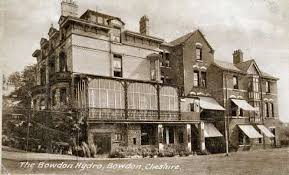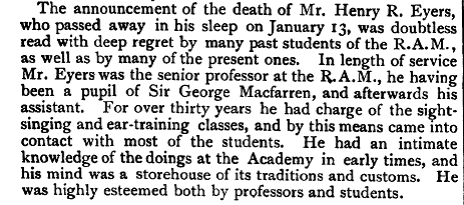In the 1860s Ireland’s father Alexander was a well-known figure in south Manchester. At this time he founded the Roundabout Club. An article by Marjorie Cox tells us more about this intriguing gathering of Bowdon’s eminent residents:
In the early 1860s a literary club, The Roundabout Club, was formed in Bowdon. The founders were Alexander Ireland, Horatio Micholls and J M D Meiklejohn. Ireland was a Scot by origin, business manager of the advanced liberal newspaper, the Manchester Examiner and Times and a leading literary and intellectual figure in Manchester; he lived first in Stamford Road and later at Inglewood, St. Margaret’s Road, where his son, the composer John Ireland, was born. Horatio Micholls was a Manchester merchant and leading Reform Jew, of Summerfield, East Downs Road and Meiklejohn was headmaster of the notable Rose Hill School for Boys in Bowdon and later Professor of Education at St Andrew’s University.
The club was named the Roundabout because its monthly meetings and dinners were held in turn at the houses of its members, who numbered twelve. Among the original members, drawn from a variety of fields, were John Mills, banker, economist, musician and music critic; John D Morell, one of the early School Inspectors (HMIs) and a leading educationist, who , in 1851, showed Matthew Arnold, newly appointed an HMI, round Manchester schools; John Watson, a well-known naturalist, and James Mudd, photographer. For the record, the other members were Mr J Leese, Mr Swanwick, Mr Fleming, Mr Marsland and Mr Phillips.
Alexander Ireland was the leading spirit of the club, inspiring it with ‘its remarkable
qualities of geniality and its unrestrained liberty of expression of opinions’. As vacancies occurred, new members were elected and there were visitors from among Ireland’s exceptionally wide range of literary friends. Ireland was noted, too, for his interest in America and his kindness to Americans. Emerson, a close friend, stayed with him in Bowdon, and in 1957 Ireland accompanied Nathaniel Hawthorne to the famous Manchester Exhibition of Art Treasures on the occasion when Tennyson was there.
It is interesting to note that James Mudd took a photograph of Tennyson during that visit to Manchester: a reproduction of it can be found in The Tennyson Album by Andrew Wheatcroft.
Ireland left Bowdon in the late 1880s and we do not know what happened to the Roundabout Club afterwards, but for over twenty years James Mudd must have belonged to it. A club which had as its centre the exceptionally well-read (he was said to have a library of 15,000 to 20,000 books) and influential Alexander Ireland, friend of Carlyle and acquainted with Wordsworth, Lamb, Leigh Hunt, De Quincey and Mrs Gaskell as well as American writers, must have been a stimulating society.

Sources: http://www.altrinchamheritage.com/wp-content/uploads/2014/11/Bowdon-Sheaf-1-1983-to-55-2015-with-Contents.pdf; http://www.altrinchamheritage.com/wp-content/uploads/2015/07/Schools-in-Victorian-Bowdon-Myra-Kendrick-1996-BHS-v6.pdf
